'Air' on the side of caution when spending this winter indoors
For humans, getting air into our bodies is as simple as breathing in.
When it comes to buildings, however, circulating fresh air is a little more complicated – and it’s never been more important for our collective public health as we all start to retreat inside for our first winter under the shadow of the coronavirus.
Jeff Elkow (Air Conditioning Engineering Technologist ’83) and Lyle Van Wieren have been thinking about and dealing with air circulation for a long time. Elkow is the founder of Exel Systems Inc., which has been a supplier of HVAC and energy-recovery equipment since 1993 – in recent years they’ve overseen work for buildings like Rogers Place in Edmonton and Calgary’s new flagship Central Library. Van Wieren, who sits on the advisory board for NAIT’s Building Environmental Systems Technology and Heating Ventilation Air Conditioning Refrigeration Technician programs, is the company’s general manager.
Here are their tips on how to ensure you’re breathing the cleanest air possible when you're indoors.
Don’t fear the hospital (especially a newer one)

Hospitals are by definition full of contagious diseases, but when it comes to air circulation, there are actually fewer places that are cleaner. If you’re inside a hospital (or school) that was built in the last 20 years, odds are you’re breathing 100% outside air, which means that nothing is allowed to cycle around inside endlessly.
If you’re inside a hospital built in the last 20 years, odds are you’re breathing 100% outside air.
“Outside air is going to be cleaner and better than recirculating the air within your space,” Elkow says. “A lot of newer hospitals already have that capability, which is going to make them a lot safer.”
Know your furnace filters

In contrast, for buildings like offices or homes, it’s unavoidable that most of the air inside is recirculated. In these buildings, the air you breathe out gets sent back to the main air system and mixed with a small amount of new outside air – usually around 10% or 20%, according to Elkow – which is then pushed back into your space again.
What can you do about it? In the office, ask around to make sure your building manager is investing in high-quality filters (a MERV rating, or measurement of filter effectiveness, of seven to 13 is appropriate for residential and light-commercial settings) and changing them regularly. Specifically, a one-inch thick filter should be changed every three months, a four-inch should last six months and larger ones go even longer.
The same goes at home. Plus, you can ensure a steady supply of fresh air by running your home furnace throughout the day, as this will trigger a new influx of outside air every time it turns on.
Keep an optimal humidity rate

One of the reasons hospitals are considered relatively safe places for airborne diseases – not just COVID-19, but also things like chickenpox and the seasonal flu – is that they keep their relative humidity at the optimal rate of 40% to 60%.
“It’s like how keeping your fridge at a certain temperature slows bacteria growth,” Van Wieren explains. “Keeping your space at the right humidity slows the transmission of disease.” It’s simply less hospitable to infectious microbes.
“Keeping your space at the right humidity slows the transmission of disease.”
This humidity level can be difficult to maintain at work or at home, especially in a northern climate like ours, but there are many humidifiers that can help, from localized units that sit in a particular room, to centralized ones that are built right into your home’s air ducts. They come at a variety of price points, but Elkow says in this case you get what you pay for.
Beware of COVID miracle cures

The Public Health Agency of Canada has recently confirmed that COVID-19 is airborne, capable of spreading through respiratory droplets and aerosols. But – so far – there are no HVAC products that are specifically designed to reduce the coronavirus’s spread.
“There isn’t a single product on the market that would advertise that, today, and if there was, you should be wary of it,” Van Wieren says. “No one’s gone through that testing yet.”
He also points out that the American Society of Heating, Refrigerating and Air-Conditioning Engineers is an international industry leader, with a task force dedicated to the pandemic. So far, they haven’t acknowledged any filtration system that has proven to be effective against COVID-19 specifically.
If all else fails, stay outside

Of course, one sure-fire way to avoid breathing stale air is to not be indoors in the first place.
Van Wieren says there’s a reason why public-health advice about the coronavirus is always more lenient to outside activities and gatherings. When choosing a space to spend time in, he says, “I would recommend choosing the one with the highest outdoor-air percentage – which is outside.”
Banner image fizkes/istockphoto.com